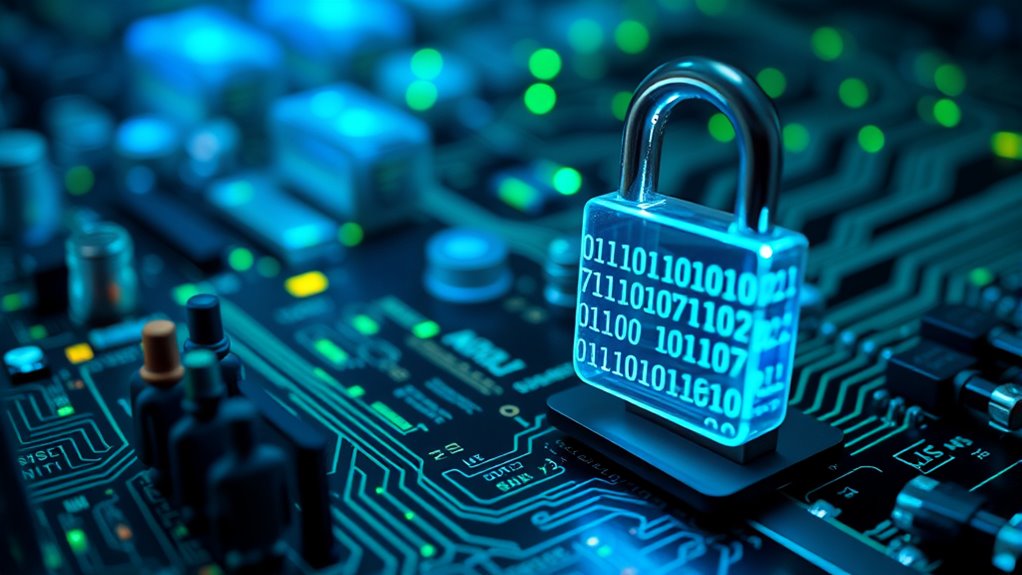AI plays a crucial role in cybersecurity by automating threat detection, streamlining resource allocation, and preventing insider risks. It identifies anomalies and responds quickly, enhancing your team’s efficiency. However, it raises privacy concerns and requires careful implementation to avoid overreach. You’ll need to regard ethical standards and stay adaptable, as cybercriminals continually evolve their tactics. If you’re interested, there’s much more to explore about the impact of AI on cybersecurity.
Key Takeaways
- AI enhances threat detection by analyzing data in real-time, identifying anomalies indicative of security breaches more quickly than manual processes.
- Automation of routine surveillance tasks improves efficiency, allowing cybersecurity teams to focus on complex security issues and respond faster to threats.
- Insider threat prevention is strengthened through AI’s ability to analyze user behavior patterns, flagging unusual activities for early intervention.
- Ethical considerations arise regarding privacy, necessitating a balance between effective monitoring and compliance with regulations to protect individual rights.
- The evolving threat landscape requires continuous updates and training to adapt AI systems and stay ahead of increasingly sophisticated cybercriminal tactics.

How can artificial intelligence transform cybersecurity? In a world where cyber threats evolve rapidly, AI’s role in cybersecurity becomes pivotal. By integrating advanced algorithms and machine learning, organizations can enhance their defenses against potential attacks. One of the most noteworthy benefits of AI in cybersecurity is its ability to perform automated threat detection. Instead of relying solely on manual monitoring, AI systems can analyze massive amounts of data in real time, identifying anomalies that might indicate a security breach. This proactive approach allows you to address vulnerabilities before they become major issues.
AI is revolutionizing cybersecurity with automated threat detection, enabling real-time anomaly identification and proactive vulnerability management.
Automated threat detection not only streamlines the monitoring process but also reduces the workload for cybersecurity professionals. You can free up valuable resources, allowing your team to focus on more complex tasks that require human insight. With AI handling the routine surveillance, the potential for quick identification of threats increases markedly. Imagine a system that alerts you the moment suspicious activity is detected, enabling you to respond promptly and effectively.
Another essential aspect of AI in cybersecurity is its role in insider threat prevention. While external threats often grab headlines, insider threats can be just as damaging, if not more so. AI-driven solutions can analyze user behaviors and identify patterns that deviate from the norm. For instance, if an employee suddenly starts accessing sensitive files they usually wouldn’t, the system can flag this behavior for further investigation. This capability allows you to intervene before insider threats escalate, protecting your organization’s data and reputation.
However, AI isn’t without its challenges. While it can enhance your cybersecurity posture, it also raises concerns about privacy and ethical considerations. The balance between effective monitoring and respecting individual privacy rights is delicate. You must ensure that your AI systems comply with regulations and ethical standards while still providing robust protection against threats. Additionally, AI’s ability to enhance absorption of other skincare products highlights the importance of continual improvement in technology to stay effective.
Moreover, as AI technology evolves, so do the methods employed by cybercriminals. Adversaries are becoming increasingly sophisticated, often developing countermeasures to bypass automated security systems. Staying ahead of these threats requires constant adaptation and improvement in your AI tools. Investing in ongoing training for both AI systems and cybersecurity personnel is essential for maintaining an effective defense.
Frequently Asked Questions
How Does AI Differentiate Between Legitimate Users and Potential Threats?
AI differentiates between legitimate users and potential threats by employing behavioral analysis and anomaly detection. It learns your typical behavior patterns and monitors activities in real time. When it spots deviations from these patterns—like unusual login times or unfamiliar device usage—it flags these anomalies as potential threats. This proactive approach helps identify risks before they escalate, ensuring that your systems remain secure while allowing genuine users seamless access to services.
Can AI Predict Cyber Attacks Before They Occur?
Yes, AI can predict cyber attacks before they occur. In fact, organizations using predictive analytics are 60% more likely to detect threats early. By analyzing vast amounts of data, AI identifies patterns and anomalies, allowing you to spot potential vulnerabilities in real-time. This proactive approach enhances threat detection, helping you strengthen your defenses against emerging threats. So, implementing AI in your cybersecurity strategy can markedly improve your organization’s resilience against cyber attacks.
What Are the Costs Associated With Implementing AI in Cybersecurity?
Implementing AI in cybersecurity can come with significant costs. You’ll face initial implementation costs, including software, hardware, and training for your team. Once it’s up and running, maintenance expenses can add up, covering ongoing support, updates, and system evaluations. Additionally, you might need to invest in further training to keep your staff current on the technology. Balancing these costs against the benefits is vital for effective cybersecurity management.
How Do Companies Ensure AI Systems Are Secure From Hacking?
To guard your AI systems against hacking, you must weave a tapestry of robust AI governance and stringent data privacy measures. Start by implementing strict access controls and regular security audits, ensuring only authorized personnel can touch the system’s delicate threads. Employ advanced encryption to shield sensitive data, and continuously train your team on emerging threats. By staying vigilant and proactive, you’ll foster a resilient environment that keeps potential intruders at bay.
What Ethical Concerns Arise From Using AI in Cybersecurity?
Using AI in cybersecurity raises ethical concerns like privacy issues and bias mitigation. You’ve got to consider how AI tools handle personal data, as they might inadvertently invade user privacy. Additionally, biases in AI algorithms can result in unfair targeting or exclusion of certain groups, making it vital to address these issues. Ensuring transparency and accountability in AI systems will help you navigate these ethical challenges effectively.
Conclusion
As you immerse yourself in the world of AI in cybersecurity, remember that it’s both a shield and a sword. While it can detect threats faster than a speeding bullet, it also comes with risks that can’t be ignored. Striking the right balance is essential, ensuring AI acts as your trusted ally against cyber threats. By staying informed and vigilant, you can harness the incredible power of AI to protect your digital landscape like a fortress against relentless attacks.









